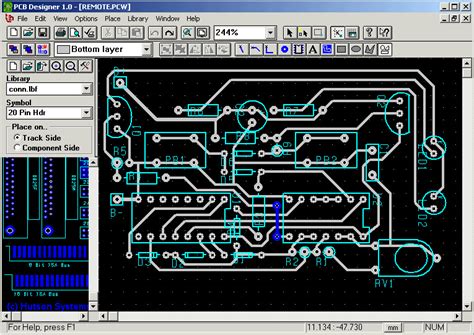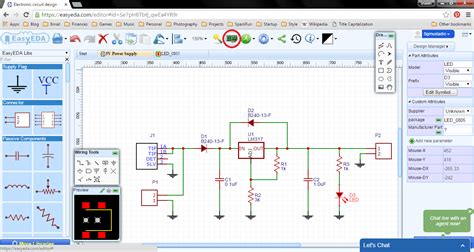What is PCB Design Software?
PCB design software is a specialized tool used by engineers and designers to create and layout printed circuit boards. These software packages offer a range of features and capabilities that streamline the PCB design process, from schematic capture to board layout and routing. By using PCB design software, designers can ensure that their PCBs are functionally correct, adhere to industry standards, and are optimized for manufacturing.
Key Features of PCB Design Software
When evaluating PCB design software, there are several key features to consider:
Schematic Capture
Schematic capture is the process of creating a graphical representation of the electronic circuit. A good PCB design software should offer an intuitive schematic editor with a comprehensive library of components and symbols. It should also support hierarchical design, allowing you to break down complex circuits into smaller, more manageable sub-circuits.
Board Layout and Routing
Once the schematic is complete, the next step is to lay out the components on the PCB and route the connections between them. The PCB design software should provide a powerful and flexible layout editor with features such as auto-placement, auto-routing, and design rule checking (DRC). It should also support multi-layer boards and provide tools for managing signal integrity and electromagnetic compatibility (EMC).
3D Visualization
Many modern PCB design software packages offer 3D visualization capabilities, allowing you to view your PCB design from various angles and check for potential mechanical interferences. This feature is particularly useful for designing complex boards with high component density or irregular shapes.
Simulation and Analysis
To ensure the reliability and performance of your PCB, it’s essential to perform simulations and analysis during the design phase. Some PCB design software includes built-in simulation tools for signal integrity, power integrity, and thermal analysis. These tools help identify potential issues early in the design process, reducing the risk of costly redesigns later on.
Manufacturing Output
Once your PCB design is complete, you’ll need to generate the necessary files for manufacturing. The PCB design software should be able to export industry-standard formats such as Gerber files, drill files, and bill of materials (BOM). It should also provide tools for generating assembly drawings and pick-and-place files.
Top PCB Design Software Options
Now that we’ve covered the key features to look for in PCB design software, let’s take a closer look at some of the top options available in the market.
1. Altium Designer
Altium Designer is a professional-grade PCB design software that offers a comprehensive set of features for schematic capture, board layout, and manufacturing output. It has a user-friendly interface and provides a seamless workflow from concept to production. Altium Designer also includes advanced features such as 3D visualization, signal integrity analysis, and automatic design rule checking.
| Feature | Description |
|---|---|
| Schematic Capture | Intuitive schematic editor with a vast library of components and symbols |
| Board Layout | Powerful layout editor with auto-placement, auto-routing, and multi-layer support |
| 3D Visualization | Realistic 3D rendering of the PCB for checking mechanical interferences |
| Simulation and Analysis | Built-in tools for signal integrity, power integrity, and thermal analysis |
| Manufacturing Output | Generates industry-standard output files for manufacturing |
2. KiCad
KiCad is a free and open-source PCB design software that has gained popularity among hobbyists and small businesses. Despite being free, KiCad offers a robust set of features for schematic capture, board layout, and manufacturing output. It has an active community of users and developers who contribute to its development and provide support through forums and documentation.
| Feature | Description |
|---|---|
| Schematic Capture | Schematic editor with a growing library of components and symbols |
| Board Layout | Capable layout editor with auto-routing and design rule checking |
| 3D Visualization | Basic 3D rendering of the PCB for visual inspection |
| Simulation and Analysis | Limited built-in simulation tools, but can export to third-party tools |
| Manufacturing Output | Generates industry-standard output files for manufacturing |
3. Eagle
Eagle is a popular PCB design software that is known for its ease of use and affordability. It offers a streamlined workflow for schematic capture, board layout, and manufacturing output. Eagle has a large community of users who contribute to its extensive library of components and design templates. While it may not have all the advanced features of more expensive software, Eagle is a solid choice for small to medium-sized projects.
| Feature | Description |
|---|---|
| Schematic Capture | User-friendly schematic editor with a large library of components |
| Board Layout | Intuitive layout editor with auto-routing and design rule checking |
| 3D Visualization | Basic 3D rendering of the PCB for visual inspection |
| Simulation and Analysis | Limited built-in simulation tools |
| Manufacturing Output | Generates industry-standard output files for manufacturing |
4. OrCAD
OrCAD is a professional-grade PCB design software that is widely used in the electronics industry. It offers a comprehensive set of features for schematic capture, board layout, and simulation. OrCAD is known for its robustness and reliability, making it a popular choice for large-scale projects and complex designs. It also integrates well with other Cadence tools for a complete electronics design workflow.
| Feature | Description |
|---|---|
| Schematic Capture | Powerful schematic editor with a vast library of components and symbols |
| Board Layout | Advanced layout editor with auto-placement, auto-routing, and multi-layer support |
| 3D Visualization | Realistic 3D rendering of the PCB for checking mechanical interferences |
| Simulation and Analysis | Comprehensive simulation tools for signal integrity, power integrity, and thermal analysis |
| Manufacturing Output | Generates industry-standard output files for manufacturing |
5. DipTrace
DipTrace is a user-friendly PCB design software that offers a complete solution for schematic capture, board layout, and manufacturing output. It has an intuitive interface and provides a smooth workflow for designing PCBs of various complexities. DipTrace also includes features such as 3D visualization, auto-routing, and design rule checking, making it a versatile choice for a wide range of projects.
| Feature | Description |
|---|---|
| Schematic Capture | Easy-to-use schematic editor with a growing library of components |
| Board Layout | Capable layout editor with auto-routing and design rule checking |
| 3D Visualization | Realistic 3D rendering of the PCB for visual inspection |
| Simulation and Analysis | Basic simulation tools for signal integrity and EMC analysis |
| Manufacturing Output | Generates industry-standard output files for manufacturing |

Choosing the Right PCB Design Software
With so many PCB design software options available, it can be difficult to determine which one is the best fit for your needs. Here are some factors to consider when making your decision:
Project Complexity
The complexity of your PCB design project should be a key factor in choosing the right software. If you’re working on simple, single-layer boards, a basic software package like Eagle or KiCad may suffice. However, if you’re designing complex, multi-layer boards with high-speed signals, you may need the advanced features offered by Altium Designer or OrCAD.
Budget
PCB design software can vary greatly in price, from free options like KiCad to high-end packages like Altium Designer that can cost several thousand dollars. Consider your budget and the long-term cost of ownership when making your decision. Keep in mind that while free software may be appealing, it may lack the features and support you need for professional-grade projects.
User Experience
The user experience is another important factor to consider when choosing PCB design software. Look for software with an intuitive interface and a smooth workflow that allows you to focus on your design rather than struggling with the tools. Many software packages offer free trials or demos, so take advantage of these to get a feel for the user experience before making a purchase.
Community and Support
Having access to a strong community of users and reliable support can be invaluable when working with PCB design software. Look for software with an active user community, comprehensive documentation, and responsive technical support. This can help you quickly overcome any challenges you may face during the design process and ensure that you’re using the software effectively.
Integration with Other Tools
If you’re using other tools in your electronics design workflow, such as simulation software or CAD packages, consider how well the PCB design software integrates with these tools. Seamless integration can streamline your workflow and reduce the risk of errors when transferring data between different software packages.

Frequently Asked Questions (FAQ)
1. What is the best free PCB design software?
KiCad is widely considered to be the best free PCB design software available. It offers a comprehensive set of features for schematic capture, board layout, and manufacturing output, and has an active community of users and developers.
2. Is Eagle better than KiCad?
Both Eagle and KiCad are capable PCB design software packages, and the choice between them largely depends on your specific needs and preferences. Eagle is known for its ease of use and affordability, while KiCad is a free and open-source alternative with a growing feature set.
3. Can I use PCB design software on a Mac?
Yes, many PCB design software packages, including Altium Designer, KiCad, and Eagle, offer versions that are compatible with macOS. However, some software may have limited features or performance on macOS compared to their Windows counterparts.
4. How much does professional PCB design software cost?
The cost of professional PCB design software can vary widely, from a few hundred dollars to several thousand dollars. High-end packages like Altium Designer and OrCAD can cost upwards of $5,000 for a single license, while mid-range options like Eagle and DipTrace are more affordable, with prices ranging from $500 to $1,500.
5. Can I import designs from one PCB design software to another?
In most cases, yes. Many PCB design software packages support industry-standard file formats such as ODB++, IPC-2581, and Gerber, which allow you to transfer designs between different software tools. However, some software may have proprietary file formats that are not compatible with other packages, so it’s important to check the import and export capabilities of the software you’re considering.
Conclusion
Choosing the right PCB design software is a critical decision that can have a significant impact on the success of your electronics projects. By understanding the key features to look for and evaluating your specific needs and budget, you can select a software package that will help you efficiently design high-quality PCBs.
While there is no one-size-fits-all solution, the top PCB design software options discussed in this article – Altium Designer, KiCad, Eagle, OrCAD, and DipTrace – each offer a range of capabilities and benefits that can suit different project requirements and user preferences. Ultimately, the best PCB design software for you will depend on your level of experience, the complexity of your projects, and your long-term goals as an electronics designer.
